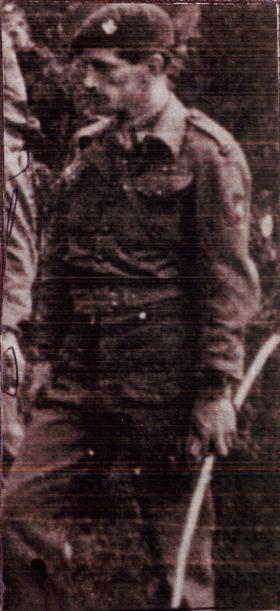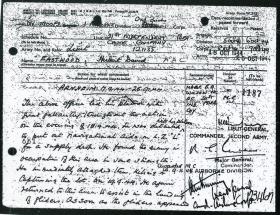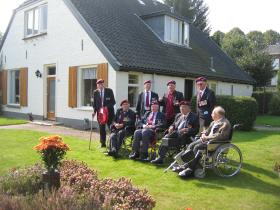Herbert David Eastwood was born on the 27th January 1919, and came from Bangor in Wales. He was at All Saints, Bloxham and St. Edmund Hall, Oxford, as an undergraduate when War was declared, and he originally enlisted into The King’s Regiment (Liverpool) at Liverpool in September 1939.
However, he did not serve with the unit, but as a Cadet Officer he attended the 167th Officer Cadet Training Unit, at Colchester, and was granted an emergency commission into The Oxfordshire & Buckinghamshire Light Infantry, as a Second Lieutenant on the 11 February 1940, and was posted to the 2nd Battalion, then stationed in India. However, along with three other infantry battalions it was recalled to the UK after the withdrawal of the BEF from France in June 1940.
This Battalion was part of the 31st Independent Infantry Brigade Group, and 2/Lieut. Eastwood was assigned the position of Liaison Officer. [1]
He was promoted to War Substantive Lieutenant on the 11 August 1941.
“I was with 1st Airborne Division from its inception – originally as Staff Captain ‘Q’ in 1st Airlanding Brigade. When the Brigade split, I went with Brigadier Hopkinson, who took over command of 1st Airborne Division, as his GSO III (Air) in which role I helped plan the Sicily operations, which was chaotic largely because pilots could not find the DZ/LZ’s, or, in some cases, Sicily itself. We went over to Italy – as infantry, because we had no aircraft at the time. When General Hopkinson was killed, and I felt free to ask for a transfer to the 21st – knowing that one of its platoon’s was to remain in Italy for operations against Southern France, and therefore a replacement platoon would be needed. It seemed to me then that Pathfinding was the area on which to concentrate and was able to say so to the ‘D’ Day planners, who asked 1st Airborne Division representatives to be interviewed on the lessons to be learned from Sicily.” [2]
‘David’ Eastwood joined the 21st Independent Parachute Company on the 23 February 1944, when the Division returned from Italy. He commanded No.1 Platoon, whose tasks on Sunday 17 September were to mark out and guard DZ-X before the 1st Parachute Brigade arrived. On the following day, the Company set about setting their beacons up on the zones for the Second Lift, whilst No.1 Platoon headed for the more isolated position of LZ-L, in order to highlight it for the attention of those aircraft bringing in supplies on that day. The lift was expected to come at 10:00, but bad weather delayed the take-off and so the Platoon waited. At midday aircraft were heard, but they were German fighters which spotted and proceeded to strafe No.1 Platoon. No casualties were suffered, however the Eureka beacon only narrowly escaped injury. As they waited, the Platoon had plenty of visitors to keep them occupied. A number of civilians were encountered, moving away from the drop zones and, they hoped, the battle. These were followed by three men of the 1st Parachute Battalion who had become separated from their unit. One of the men was an officer who had, on the previous night, had cause to take shelter in what he thought was a fox hole but he soon realised that it was a sewerage pit. He had the good grace to sit down wind of his hosts. The news that these men passed on to the Platoon about the progress they had been making was not at all promising, a feeling which was increased with the sound of an armoured vehicle passing by.
On the following day, No.1 Platoon returned to LZ-L to mark it for the arrival of the Polish gliders. Again they were attacked by numerous German fighters and terrifying though this was, no casualties were suffered, mostly because the Platoon were now wary of the threat from the air and so had taken the trouble to dig in deep.
The Independent Company were involved in a controversial incident on Wednesday 20th. The Germans had been in the habit of calling upon the British to surrender, and though the details are not clear it does appear that the Independent Company lured their opponents into a ruse de guerre. After a period of mortaring a German shouted out "surrender". It was not clear whether they intended to surrender or were calling upon the Independent Company to surrender. One of No.1 Platoon's German Jews, Corporal Max Rodley (real name Hans Rosenfeld), was told by Major Wilson to call upon them to come out into the open to come and get them. It is believed that as many as 50 Germans came forward, all armed and none displaying the slightest sign of submission. Lieutenant Eastwood might have been unsure about this fact and said to Rodley, who was calling upon them to lay down their arms, "Tell them we'll give them a minute". When they were within point blank range the glider pilots on the left flank of the Independent Company opened up with their Brens on this group and No.1 Platoon quickly added their weight to the slaughter. Few Germans escaped. Almost as soon as the firing started, David Eastwood, whose face went white and grim, called for a cease fire. It does, however, appear that the Germans were coming across to accept the surrender of the Independent Company, and though a ruse de guerre is totally acceptable, if unchivalrous ploy of war, it would be wrong to assume this was anything other than a highly confused situation for all concerned.
For his actions at Arnhem, Lieutenant Eastwood was awarded the Military Cross, which was announced in the London Gazette on the 9 November 1944:
The above officer led his platoon with great gallantry throughout the action. On the evening of 18.9.44, he was detailed with his platoon to put out navigational aids on LZ "L" for a supply drop. He found the enemy in occupation of this area in some strength. He immediately attacked them, killing or capturing the lot. On 19.9.44, he again returned to this area to assist in the landing of gliders. As soon as the gliders appeared the enemy put in an attack. This was driven off and the enemy held until all the gliders had been unloaded. Later he found that his route back to the Company area had been cut off by the enemy, but he successfully led his platoon through the enemy positions.
From 20.9.44 until the withdrawal on 25.9.44, he held a position which was constantly exposed to murderous enemy fire, but regardless of personal danger he went constantly round his section positions encouraging his men. His great example undoubtedly kept the spirits of his men at such a high level that in spite of numerous enemy attacks and heavy casualties they hung on to their positions until the end.
David went on to serve with the 21st Independent Parachute Company in Norway in May 1945, but transferred to a unit bound for Malaya, as that is where his peacetime job was to be!
He relinquished his commission on the 24 September 1946, but was granted the Honorary rank of Captain.
Following the his departure from the Army, David Eastwood joined the colonial Malayan Civil Service in 1947. He learned to speak Malay and served there during the Malay Emergency. Eastwood became district commissioner for Trengganu, on the country’s eastern coast, where he wrote the Land Law for the State before going to Malacca. Returning to England after Malaya achieved independence in 1957, he joined the Ministry of Defence in 1959. After serving in Jamaica he completed a four-year tour of Northern Ireland during The Troubles, working in intelligence for the Northern Ireland Office. He was invested as a Commander of the Order of the British Empire in 1973.
David retired from the Ministry of Defence on the 15 December 1978.
David Eastwood died on the 29th October 2010 and his ashes were interred at the Arnhem/Oosterbeek War Cemetery at 11.00 hours on Friday 16th September 2011.
NOTES:
[1] 2nd Bn, The Ox & Bucks, L.I. War Diary. September 1940.
[2] Letter to Bob Hilton. February 1996.
Here follows the citation for Lt Eastwood's Military Cross:
'The above officer led his platoon with great gallantry throughout the action. On the evening of 18.9.44, he was detailed with his platoon to put out navigational aids on L.Z. "L" for a supply drop. He found the enemy in occupation of this area in some strength. He immediately attacked them, killing or capturing the lot. On 19.9.44, he again returned to this area to assist in the landing of gliders. As soon as the gliders appeared the enemy put in an attack. This was driven off and the enemy held until all the gliders had been unloaded. Later he found that his route back to the Company area had been cut off by the enemy, but he successfully led his platoon through the enemy positions.
From 20.9.44 until the withdrawal on 25.9.44, he held a position which was constantly exposed to murderous enemy fire, but regardless of personal danger he went constantly round his section positions encouraging his men. His great example undoubtedly kept the spirits of his men at such a high level that in spite of numerous enemy attacks and heavy casualties they hung on to their positions until the end.'
Compiled with kind assistance from Phil Jennett and R Hilton.
Read More



Latest Comments
There are currently no comments for this content.
Add Comment
In order to add comments you must be registered with ParaData.
If you are currently a ParaData member please login.
If you are not currently a ParaData member but wish to get involved please register.